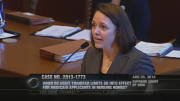 Does federal Medicaid law allow the unlimited transfer of assets between spouses after one spouse is institutionalized, but before Medicaid eligibility is determined? On Wednesday, August 20, 2014, the Supreme Court of Ohio heard oral arguments in a case that turns on this question. Estate of Atkinson v. Ohio Department of Job and Family Services, No. 2013-1773.
Does federal Medicaid law allow the unlimited transfer of assets between spouses after one spouse is institutionalized, but before Medicaid eligibility is determined? On Wednesday, August 20, 2014, the Supreme Court of Ohio heard oral arguments in a case that turns on this question. Estate of Atkinson v. Ohio Department of Job and Family Services, No. 2013-1773.
As ElderLawAnswers previously reported, in 2000 Marcella Atkinson and her husband transferred their home into a revocable living trust. In April 2011, Mrs. Atkinson entered a nursing home and soon applied for Medicaid benefits. In August 2011, the home was removed from the trust and placed in Mrs. Atkinson's name. The next day, Mrs. Atkinson transferred the house to her husband. The state determined an improper transfer had occurred and imposed a penalty period. Mrs. Atkinson passed away, and her estate appealed to court, losing at both the trial court and the Ohio Court of Appeals. The estate has been represented by, among others, ElderLawAnswers member Thom L. Cooper of Cooper, Adel & Associates in Centerburg, Ohio.
During the 40 minutes of oral arguments (available on video here) before the state’s high court, the attorney for the estate, Maura L. Hughes, maintains that both federal and state Medicaid law clearly allow unlimited transfers up to the point of Medicaid’s eligibility determination, and that both the Sixth Circuit Court of Appeals and the Department of Health and Human Services (HHS) support this reading of the statutes.
Stephen P. Carney, the attorney for the state, tells the justices that both the Sixth Circuit and HHS “got it wrong,” and that “the curtain comes down on unlimited transfers at the date of institutionalization.” If couples are allowed to continue reallocating their assets after the date of institutionalization, he argues, they will be able to easily protect assets through “various tricks,” such as annuities. “If you can still do unlimited spousal transfers even after institutionalization, then you could take 200, 300, $400,000 as in some of our other cases and convert it from what’s a shared resource into this protected income stream for the community spouse.”
Some justices appeared surprised at Carney’s suggestion that they should second-guess both the Sixth Circuit and HHS (which weighed in on the Sixth Circuit case). One justice asked attorney Hughes whether the state is bound by the Sixth Circuit’s decision, in which, coincidentally, the appellant’s name was Hughes.
“I believe they are, your honor,” said Hughes. “My understanding is that they are not actually following it now. There was a U.S. district court case filed last week alleging that the state has been holding for this case in hopes of getting a second bite at the apple and having you come out in the opposite direction from the Hughes decision.”
For the Supreme Court of Ohio’s oral argument preview on the case, click here.
For detailed case information, click here.


